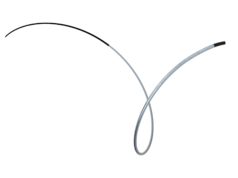
Embolx has announced the commercial availability of the new Sniper K-tip in the USA and Europe. The sniper balloon occlusion family of microcatheters now includes the new K-tip, a 45-degree angled tip designed to enhance tracking and vessel access capabilities. This extension to the sniper family offers physicians the ability to customise treatment with an array of different balloon microcatheter lengths and tip options.
“The Sniper K-tip marks the first pre-shaped tip on a balloon microcatheter and has shown remarkable performance in accessing target locations previously too challenging to reach,” says Michael Allen, president and CEO of Embolx. “For interventional radiologists, the K-tip provides an additional option to handle complex anatomies so they can achieve improved results.”
The sniper microcatheters are now available with two tip options—straight tip or K-tip—and in three lengths: 110cm, 130cm and 150cm. The K-tip offers interventional radiologists better control and torqueability through hard-to-navigate vessels to deliver targeted embolization treatment, a press release states.
“Sniper has changed the way I do both chemoembolization and radioembolization. With sniper, I am able to infuse a higher volume of embolic agent into a smaller, focused area. This allows me to treat tumours more aggressively with less impact on normal liver tissue,” comments Brian Kouri, associate professor in interventional radiology at Wake Forest Baptist Medical Center, Winston-Salem, USA. “My initial case experience with sniper’s new K-tip design has been great in every respect. It allowed me to access some pretty small vessels quickly and navigate an over 180-degree vessel turn into the right gastric artery. The tip performance is impressive as it easily tracks inside vessels and torques on a one-to-one basis allowing the sniper to make sharp vessel turns.”
The sniper microcatheter alters blood flow‐dynamics by controlling pressure to increase therapeutic agent delivery into target areas. It is currently used for the treatment of cancerous tumours in the liver and other organs, enlarged prostate (benign prostatic hyperplasia), and uterine fibroids. This therapy allows the delivery of drugs and embolic agents to only targeted treatment areas, while protecting surrounding healthy tissues.
The sniper balloon occlusion microcatheter has been used in over 2,500 cases in hospitals within the USA and Europe to date.













